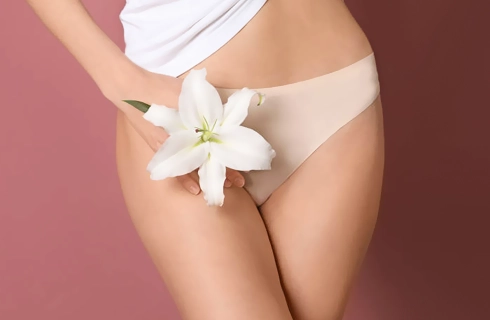
The vaginal flora, which consists of beneficial bacteria in the vagina, helps prevent the growth of harmful bacteria and fungal infections.
Conditions such as estrogen deficiency due to menopause, washing the genital area with unsuitable shampoos, washing the vagina after urination, antibiotic use, pregnancy hormones, lace underwear, and using scented daily pads reduce the number of beneficial bacteria (lactobacilli). As a result, vaginal yeast overgrowth increases, leading to a vaginal candidiasis (fungal) infection. In vaginal yeast infections, the discharge is thick, odorless, and similar to yogurt curds.
Vaginal yeast infections often cause intense itching and swelling. Treatment for vaginal yeast infections includes oral medication, vaginal suppositories, and creams. However, especially in cases of recurrent vaginal yeast infections, medication alone may not provide a definitive solution. Vaginal yeast laser treatment helps by regulating the vaginal tissue, preventing the recurrence of discharge.
Any condition that causes a decrease in the number of lactobacilli, the beneficial bacteria in the vaginal flora, can lead to a vaginal yeast infection. Some of the causes include:
These conditions can cause recurring vaginal yeast infections even after the discharge is treated with medication.
The traditional treatment for vaginal yeast infections includes oral medications, vaginal suppositories, and creams. However, to prevent recurrence, it is crucial to restore the vaginal flora (beneficial bacteria/lactobacilli). There are two methods to achieve this:
The first step for a patient presenting with vaginal discharge is to determine if medication is necessary. If the symptoms of itching and recurrent discharge are found to be caused by a yeast infection, vaginal laser treatment is applied.
The laser treatment for vaginal yeast infections takes about 10 minutes. The procedure is painless, and patients can return to their social and work activities immediately afterward. Sexual intercourse is not recommended during the first week after the laser treatment.
There are no restrictions on taking showers or engaging in sports. Generally, a single session of vaginal laser treatment is sufficient, but in cases of frequent recurrence of vaginal yeast infections, a second session may be needed. The sessions should be spaced 3 to 4 weeks apart.
To eliminate vaginal yeast discharge and prevent future occurrences, certain precautions should be taken:
By following these guidelines, the risk of developing or recurring vaginal yeast infections can significantly decrease.
The main issue in recurrent vaginal infections is the lack of vaginal flora (beneficial bacteria-lactobacilli). The vaginal flora can be regulated with methods like daily use of probiotic suppositories, but this can be cumbersome for the patient. In cases of recurrent infections, laser treatment can support the vaginal flora in a single session, create a protective barrier in the vagina, and prevent further infections.